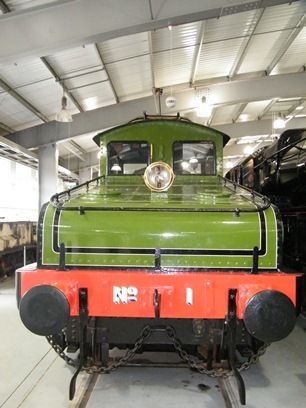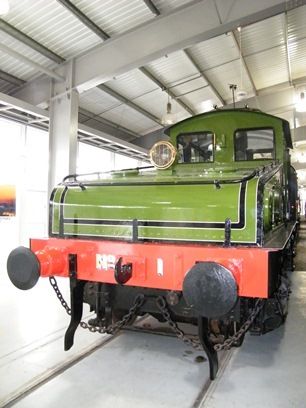Electric Locomotive No 1 in 2009 - the bufferbeam is the original one which had cracked, and has since been replaced as seen in the other photographs taken in 2012
In 1902, the North Eastern Railway took the decision to electrify the Tyneside suburban passenger lines in the Newcastle-upon-Tyne area to compete with the new electric tramways in the area which were having an effect on passenger numbers. At the same time, it was decided to electrify the Newcastle Quayside Branchline, a freight line which ran from the Trafalgar Yard at Manors station down to the sidings on the Newcastle Quayside, a short but very important line. The line included a steep curved tunnel down to the Quayside, which was difficult to work with steam locomotives as the steam and smoke had a major impact on visibility for the engine crews, and as well as that the sparks were easily setting alight to the straw used as packing in the wagons. As part of the electrification of the line, which had overhead wires at Trafalgar Yard and in the Newcastle Quayside Sidings and a third rail system like the Tyneside line for work in the tunnels where clearance was restricted, two BO-BO (meaning the wheel configuration was of a pair of bogies which had a central pivot to allow it to navigate tight corners, with each bogie having four wheels) electric locomotives were ordered on 15th December 1902 from British Thomson-Houston, with the frames and bodies built by Brush at Loughborough, Leicestershire to the 'steeplecab' design (meaning the cab is in the centre of the locomotive), similar to other electric locomotives built at the same time. British Thomson-Houston built the electrical components at their site at Rugby, Warwickshire.
The locomotives, built in 1904 and entering service in July 1905, picked up their power from shoes on the bogies which took the electrical current from contact with the third rail both in the tunnels and over the Tyneside suburban lines to the sheds at South Gosforth where the locomotives and the Tyneside electric stock were kept when not in use.
Originally the two locomotives were fitted with a large bow collector which was mounted on a wooden beam halfway across one of the sloping bonnets at either end of the locomotive which changed angle with the direction the locomotive travelled in, but in 1905, following tests at Trafalgar South Yard where they were to operate, this was changed to a pantograph on the cab roof before they entered service in June of that year. The pantographs were extended when in use to make contact with overhead lines or pulled down to a flattened position when not in use when the locomotive was picking up electric current from the 'third rail' - this was especially important when travelling through the tunnels, where it would be damaged against the tunnel mouth if not pulled down in time! The locomotives went into LNER service when the North Eastern Railway was grouped together with other railway lines in the north eastern and eastern areas in 1923 and became known as the ES1 class (Electric Shunting 1), which they are best known as now. Both locomotives gave good service and were kept in use until 29th February 1964 when they were withdrawn, nearly sixty years after entering service. They were replaced by diesel locomotives but the line itself was closed in 1969 and is now virtually unrecogniseable. No 1 Locomotive was preserved as part of the National Collection, and is now on display at the National Railway Museum's outpost at Shildon, Durham, known as 'Locomotion', which interestingly is where the North Eastern Railway's freight line originated on it's way to Middlesbrough, opening in 1915. Electric Locomotive No 2 was apparently also planned to be preserved but this plan fell through, and it was scrapped in 1966. Locomotive No 1 is now in it's original North Eastern Railway colour scheme, representing not it's strictly original condition, but from 1905 onwards (just before entering NER service) with the pantograph on the cab roof





No comments:
Post a Comment